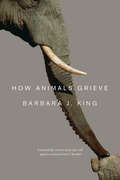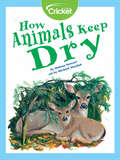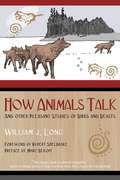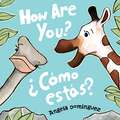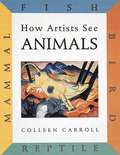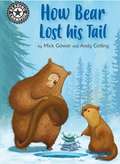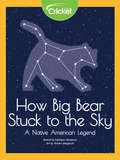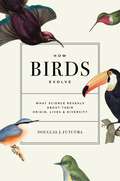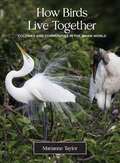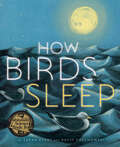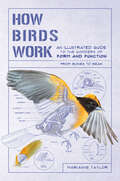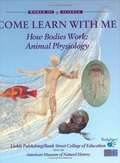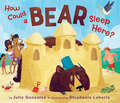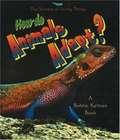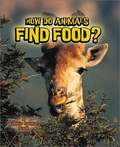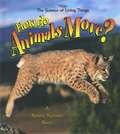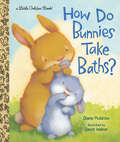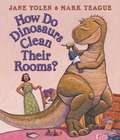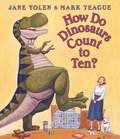- Table View
- List View
How Animals Grieve
by Barbara J. KingFrom the time of our earliest childhood encounters with animals, we casually ascribe familiar emotions to them. But scientists have long cautioned against such anthropomorphizing, arguing that it limits our ability to truly comprehend the lives of other creatures. Recently, however, things have begun to shift in the other direction, and anthropologist Barbara J. King is at the forefront of that movement, arguing strenuously that we can and "should" attend to animal emotions. With "How Animals Grieve," she draws our attention to the specific case of grief, and relates story after story from fieldsites, farms, homes, and more of animals mourning lost companions, mates, or friends. King tells of elephants surrounding their matriarch as she weakens and dies, and, in the following days, attending to her corpse as if holding a vigil. A housecat loses her sister, from whom she's never before been parted, and spends weeks pacing the apartment, wailing plaintively. A baboon loses her daughter to a predator and sinks into grief. In each case, King uses her anthropological training to interpret and try to explain what we see to help us understand this animal grief properly, as something neither the same as nor wholly different from the human experience of loss. The resulting book is both daring and down-to-earth, strikingly ambitious even as it is careful to acknowledge the limits of our understanding. Through the moving stories she chronicles and analyzes so beautifully, King brings us closer to the animals with whom we share a planet, and helps us see our own experiences, attachments, and emotions as part of a larger web of life, death, love, and loss.
How Animals Keep Dry
by Melissa StewartMany animals take cover when it rains. They like to stay warm and dry too!
How Animals Protect Themselves (Rigby Leveled Library, Level Q #62)
by Pamela RushbyNIMAC-sourced textbook
How Animals Talk: And Other Pleasant Studies of Birds and Beasts
by William J. Long Marc Bekoff Rupert SheldrakeThe classic and original text that first explored the telepathic methods of communication of wild animals • Based on years of detailed field observations, first published in 1919 • Written by the famous American naturalist who was the first to study telepathy in the wild • Forewords by biologists Rupert Sheldrake, who has spent 15 years researching the unexplained powers of animals, and Marc Bekoff, the editor of the three-volume Encyclopedia of Animal Behavior Many sources have commented on the silent communication abilities of pets, but never before and not since the first publication of this book in 1919 has the subject of animal telepathy in the wild been so fully researched. How Animals Talk explores the phenomenon of vocal, silent, and even motionless communication among animals. From crow talk to instant herd communication, author William J. Long theorizes that animals are much more intelligent, emotional, and moral than we have traditionally thought and that their ability to sense the presence of other living beings is an innate ability shared by humans as well. Based on many years of field observations, this classic text contains numerous examples of animal behavior that defy conventional explanation. Long believed in the importance and validity of anecdotal evidence. He recognized the dangers of conventional research in reducing animals to mere numbers and how the cold third-person prose of scientific study can objectify animals, distancing "us" from "them." His findings on the impact of our presence on animal life--and the cost that we pay in separating ourselves from animals, who help define our place in the natural world--may be more relevant today than ever before.
How Are You? / ¿Cómo estás? (Spanish bilingual)
by Angela DominguezFriendship awaits in this bilingual book about feelings, How Are You? / ¿Cómo estás? by Angela Dominguez-- expressed both in English and in Spanish.When two giraffe friends find a baby ostrich, they have some questions. Is baby ostrich hungry? Shy? Tired? Ostrich says no! So how does she feel?
How Artists See Animals: Mammal, Fish, Bird, Reptile
by Colleen CarrollExamines how different kinds of animals have been depicted in works of art from different time periods and places.
How Bear Lost His Tail: Independent Reading 11 (Reading Champion #298)
by Mick GowarA fun retelling of this Native American legend. Bear is tricked by Otter into fishing with his beautiful, long tail - and it ends up getting frozen and snapping off!Reading Champion offers independent reading books for children to practise and reinforce their developing reading skills.Fantastic, original stories are accompanied by engaging artwork and a reading activity. Each book has been carefully graded so that it can be matched to a child's reading ability, encouraging reading for pleasure.The Key Stage 2 Reading Champion Books are suggested for use as follows:Independent Reading 11: start of Year 3 or age 7+Independent Reading 12: end of Year 3 or age 7+Independent Reading 13: start of Year 4 or age 8+Independent Reading 14: end of Year 4 or age 8+Independent Reading 15: start of Year 5 or age 9+Independent Reading 16: end of Year 5 or age 9+Independent Reading 17: start of Year 6 or age 10+Independent Reading 18: end of Year 6 or age 10+
How Big Bear Stuck to the Sky
by Kathleen MuldoonOne of the most well-known constellations in the night sky, the Big Dipper, traces its origins to a Native American legend. Many animals attempted to break through Sky in order to spread light and warmth onto the Earth. Only one of them, a Great Bear—also known as Ursa Major—succeeds. How does Great Spirit reward him?
How Birds Evolve: What Science Reveals about Their Origin, Lives, and Diversity
by Douglas J. FutuymaA marvelous journey into the world of bird evolutionHow Birds Evolve explores how evolution has shaped the distinctive characteristics and behaviors we observe in birds today. Douglas Futuyma describes how evolutionary science illuminates the wonders of birds, ranging over topics such as the meaning and origin of species, the evolutionary history of bird diversity, and the evolution of avian reproductive behaviors, plumage ornaments, and social behaviors.In this multifaceted book, Futuyma examines how birds evolved from nonavian dinosaurs and reveals what we can learn from the "family tree" of birds. He looks at the ways natural selection enables different forms of the same species to persist, and discusses how adaptation by natural selection accounts for the diverse life histories of birds and the rich variety of avian parenting styles, mating displays, and cooperative behaviors. He explains why some parts of the planet have so many more species than others, and asks what an evolutionary perspective brings to urgent questions about bird extinction and habitat destruction. Along the way, Futuyma provides an insider's perspective on how biologists practice evolutionary science, from studying the fossil record to comparing DNA sequences among and within species.A must-read for bird enthusiasts and curious naturalists, How Birds Evolve shows how evolutionary biology helps us better understand birds and their natural history, and how the study of birds has informed all aspects of evolutionary science since the time of Darwin.
How Birds Live Together: Colonies and Communities in the Avian World
by Marianne TaylorA beautifully illustrated exploration of the ways birds cohabitFeaturing dramatic and delightful wild bird colonies and communities, How Birds Live Together offers a broad overview of social living in the avian world. From long-established seabird colonies that use the same cliffs for generations to the fast-shifting dynamics of flock formation, leading wildlife writer Marianne Taylor explores the different ways birds choose to dwell together.Through fascinating text, color photos, maps, and other graphics, Taylor examines the advantages of avian sociality and social breeding. Chapters provide detailed information on diverse types of bird colonies, including those species that construct single-family nests close together in trees; those that share large, communal nests housing multiple families; those that nest in tunnels dug into the earth; those that form exposed colonies on open ground and defend them collectively, relying on ferocious aggression; those that live communally on human-made structures in towns and cities; and more. Taylor discusses the challenges, benefits, hazards, and social dynamics of each style of living, and features a wealth of species as examples.Showcasing colonies from the edge of Scotland and the tropical delta of the Everglades to the Namib Desert in Africa, How Birds Live Together gives bird enthusiasts a vivid understanding of avian social communities.
How Birds Sleep
by David ObuchowskiDiscover the mysterious and fascinating sleeping habits of more than twenty bird species from around the world in this gorgeously illustrated read-aloud picture book, perfect for bedtime, or any time.Have you ever seen a bird sleep? Or wondered just when it is that migrating cranes find the time to catch Z&’s as they cross the ocean? From the parrots of Thailand to the ostriches of Australia and even the pigeons of New York City, every bird sleeps—but they do it in ways that will surprise and delight you. Some hang from tree branches, others doze while gliding, and some even burrow underground for a nap. Written in a witty, conversational voice, and with gorgeous illustrations, this picture book is bursting with interesting facts about this underexplored aspect of bird life all around us.
How Birds Work: An Illustrated Guide To The Wonders Of Form And Function--from Bones To Beak (How Nature Works #0)
by Marianne TaylorEngineered by evolution to thrive in the wild A tiny textbook to learn on your own How Birds Work goes beyond the typical field guide to show us not only what birds look like but why. Why do many owls have asymmetrical ear openings? (Hint: It helps them pinpoint prey; see page 40.) And why does the Grey Heron rest on one leg at a time? (Hint: Not because it’s tired; see page 66!) Birds boast a spectacular array of adaptations suited to their incredibly diverse diets and habitats. In this in-depth handbook, discover the ways they’re even more astounding than you know—inside and out. Detailed analysis and illustrations illuminate: Skeleton Muscles Circulation Digestion Respiration Reproduction Feathers Colors and Patterns And much, much more!
How Bodies Work: Animal Physiology
by Bridget AndersonDo you ever wonder what makes you grow? Or why you shiver when you are cold? Have you ever marveled at the speed of a cheetah, the fastest land animal on Earth? Or been awed at how a chameleon can change color? Solving such mysteries is part and parcel of animal physiology, the science that investigates how different animal bodies work. Learning how they do increases our appreciation of the uniqueness and diversity of the vast animal kingdom, and adds to our understanding of how our own bodies work. HOW BODIES WORK: ANIMAL PHYSIOLOGY offers a glimpse inside ourselves and the amazing world around us.
How Can Animals Use Their Senses to Communicate?: Student Activity Guide
by The Smithsonian InstitutionNIMAC-sourced textbook
How Caterpillars Turn Into Butterflies (Nature's Mysteries Ser.nature's Mysteries)
by Jill BaileyYoung readers can learn about many of the most amazing aspects of nature in this strikingly illustrated set of books. Ideal for the reader who must know how nature works, this series has the answers to many questions, helping to open up the world of nature's secrets.
How Could a Bear Sleep Here?
by Julie GonzalezIt's time for Shelby to hibernate, but how could a bear sleep in this noisy forest?The woodpeckers are rat-tat-tatting, the squirrels are cracka-cracka-crunching--there's too much noise! When Shelby spies the perfect cave, only too late does he realize he's hopped aboard a tour bus bound for the beach.Coupled with hysterically expressive illustrations by Stephanie Laberis, Julie Gonzalez's lively text and familiar refrain sings as Shelby, after several attempts to snooze in the tropics with increasing exhaustion, finally discovers the perfect solution to his noise problem. This is a great read-aloud for young readers who will recognize the refrain ("How could a bear sleep here?") and the silliness of Shelby's predicament
How Deep Is the Ocean? (Let's-Read-and-Find-Out Science 2)
by Kathleen Weidner ZoehfeldRead and find out about the deepest part of the ocean in this colorfully illustrated nonfiction picture book.The ocean covers almost three-quarters of the Earth, but how deep does it go? Put on your scuba gear and explore the ocean, from its shallowest waters to its deepest, most mysterious parts. As you dive deeper, you’ll discover glowing animals, strange creatures that don’t need sunlight to survive, and even the largest hunter in the world.With beautiful illustrations and engaging text, How Deep Is the Ocean? will guide young readers into the deepest parts of the ocean. Featuring a find-out-more section with a water-pressure experiment, a lesson in making a sounding line to learn how scientists measure the depth of the ocean, a glossary of new terms, and web research prompts, this book will begin children’s explorations of the deep sea. Both the text and the artwork were vetted for accuracy by Dr. David Gruber, real-life deep sea explorer and professor of biology and environmental science at Baruch College.This is a clear and appealing science book for early elementary age kids, both at home and in the classroom. It's a Level 2 Let's-Read-and-Find-Out, which means the book explores more challenging concepts for children in the primary grades. The 100+ titles in this leading nonfiction series are:hands-on and visualacclaimed and trustedgreat for classroomsTop 10 reasons to love LRFOs:Entertain and educate at the same timeHave appealing, child-centered topicsDevelopmentally appropriate for emerging readersFocused; answering questions instead of using survey approachEmploy engaging picture book quality illustrationsUse simple charts and graphics to improve visual literacy skillsFeature hands-on activities to engage young scientistsMeet national science education standardsWritten/illustrated by award-winning authors/illustrators & vetted by an expert in the fieldOver 130 titles in print, meeting a wide range of kids' scientific interestsBooks in this series support the Common Core Learning Standards, Next Generation Science Standards, and the Science, Technology, Engineering, and Math (STEM) standards. Let's-Read-and-Find-Out is the winner of the American Association for the Advancement of Science/Subaru Science Books & Films Prize for Outstanding Science Series.
How Do Animals Adapt? (The Science of Living Things)
by Bobbie KalmanCertain sea slugs have developed a remarkable defensive adaptation--they can use the stinging cells of the sea anemones they eat to protect themselves. Whether adapting over millions of years or in the blink of an eye, How Do Animals Adapt? examines the ever-changing world of animals. Children will thrill at discovering: *why animals need to adapt *animals that can "see" using sounds *how animals use camouflage and mimicry to protect themselves *how wild animals have adapted to habitat loss and learned to live in cities
How Do Animals Find Food?
by Bobbie KalmanWith so many species competing for food, animals have developed fascinating methods of finding the food that keeps them fat and happy. How do animals find food? Lets children in on such techniques as pack and solitary hunting, and poisonous animals.
How Do Animals Move?
by Bobbie Kalman Niki WalkerSlithering snakes, jumping kangaroos, flying albatrosses, and swimming salmon--every animal, including humans, has its own unique way of getting around. This beautiful new book explains the how, why, and "are we there yet?" of animals large and small across the globe. Topics include: *how an animal's environment affects its movement *how an animal's skeleton affects its movement *unusual animal movers such as the water-walking basilisk *how a parent helps its young move around
How Do Bunnies Take Baths? (Little Golden Book)
by Diane MuldrowThe perfect book to read before bathtime--a new Little Golden Book about the different ways animals keep themselves clean.Tigers love to soak in a cold lake or stream.Macaques relax in hot water steam!Beavers comb their fur to remove what's cruddy.Rhinos roll around in a bath that's muddy!This delightful rhyming Little Golden Book shares fun facts about how bunnies, zebras, cats, elephants, and many other animals keep themselves clean. Young boys and girls will love comparing their bathtime to those of the adorable animals in this new book from New York Times bestselling author Diane Muldrow (Everything I Need to Know I Learned From a Little Golden Book series) and beloved illustrator David Walker (How Do Penguins Play?, Bears on Chairs).
How Do Dinosaurs Clean Their Rooms?
by Jane Yolen Mark TeagueThe bestselling, award-winning team of Yolen and Teague present their second original dinosaur board book, a playful "how-to" tale about making a mess and then cleaning it up. Come along for some BIG fun as your favorite dinosaurs learn to pick up and put away their toys. How do dinosaurs clean their rooms? With trash cans and dusters and brooms! Brimming with the same infectious humor as the other HOW DO DINOSAURS tales, this new board book is a perfect companion to the immensely popular picture books and a great baby gift as well. Image descriptions present
How Do Dinosaurs Count to Ten?
by Jane Yolen Mark TeagueCome along for some BIG fun as your favorite dinosaurs delight young readers with their playful antics. How do dinosaurs count to ten? Over and over and over again! Image descriptions present
How Do Dinosaurs Eat Their Food?
by Jane YolenThese terrible lizards have correspondingly terrible table manners; they burp, hurl spaghetti, and gleefully shove green beans up a giant reptilian nostril. Subsequent scenes of dinos "sit[ting] quite still" and beaming with "smiles and goodwill" offer examples of correct behavior; but even the mealtime "don'ts" offer useful information in hand-painted labels identifying each kaleidoscopically patterned creature. Don't miss queztalcoatus screeching at a restaurant waitress, or upersaurus inspecting his nutritious supper Kids will chortle over clever images of adults dwarfed by toothy miscreants, and both parents and children will recognize the hilarious parallels with occasionally naughty human kids who loom dinosaur-large within their respective households.
